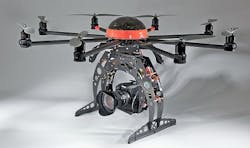Bulgaria shopping for all-weather 10-pound reconnaissance drones to fly in daylight and at night
ABERDEEN PROVING GROUND, Md., 14 July 2014. The U.S. Army is surveying the unmanned aerial vehicle (UAV) industry for 10-pound drones with hover and stare capability that would be suitable for the Bulgarian armed forces.
Officials of the Army Contracting Command at Aberdeen Proving Ground, Md., issued a sources-sought notice last week (MARKET-SURVEY-J1-B-UAG) to locate potential sources to deliver and train vertical take-off and landing (VTOL) UAV systems for foreign military sales to Bulgaria.
Companies interested have to work fast because the Army wants all responses to this market survey to be in by the end of this week.
These UAVs for Bulgaria should weigh less than 10 pounds without payload, have hover and stare capability, be able to fly for at least 25 minutes at ranges of nearly two miles between fueling or recharging, be able to operate in all weather during the day and at night, have stable flight in wind gusts as strong as 56 miles per hour.
Related: FAA's impending rule on small UAVs may usher in a new era of civil aerial warfare
These UAVs should be no larger than four feet square and 15 inches high, provide tool-less assembly and deployment, interface with GPS camera targeting and real-time digital video, operate on an encrypted data network, and work with software that enables at least four UAVs flying missions at the same time.
These UAVs must be able to carry one of two kinds of payloads. The first kind of payload has a 10x optical zoom camera with weatherproof enclosure that connects quickly to the UAV. It must have gimbal-mounted digital video with motion compensation of at last 100 degrees per second and range of motion of at least plus-or-minus 15 degrees.
The second payload type is a thermal imaging camera with quick-connect weatherproof enclosure, exportable digital video frame rate of last 7 Hz and full frame rate of at least 25 Hz. The camera should be gimbal mounted with at least 100 degrees-per-second motion compensation, range of motion of at least plus-or-minus 15 degrees, 25-degree field of view, and resolution of at least 640 by 480 pixels.
Related: Electro-optical sensor payloads for small UAVs
The UAVs and their payloads must be able to operate in temperatures from -25 to 60 degrees Celsius, and at altitudes as high as 30,000 feet above sea level. Training requirements should be minimal.
Companies able to supply these kinds of UAVs should respond no later than 18 July 2014 to the Army's Megan Grigas by email at [email protected], or by phone at 410-278-3820.
More information is online at https://www.fbo.gov/notices/ba74c11df314e24189331f2a1ab14771.

John Keller | Editor
John Keller is editor-in-chief of Military & Aerospace Electronics magazine, which provides extensive coverage and analysis of enabling electronic and optoelectronic technologies in military, space, and commercial aviation applications. A member of the Military & Aerospace Electronics staff since the magazine's founding in 1989, Mr. Keller took over as chief editor in 1995.

